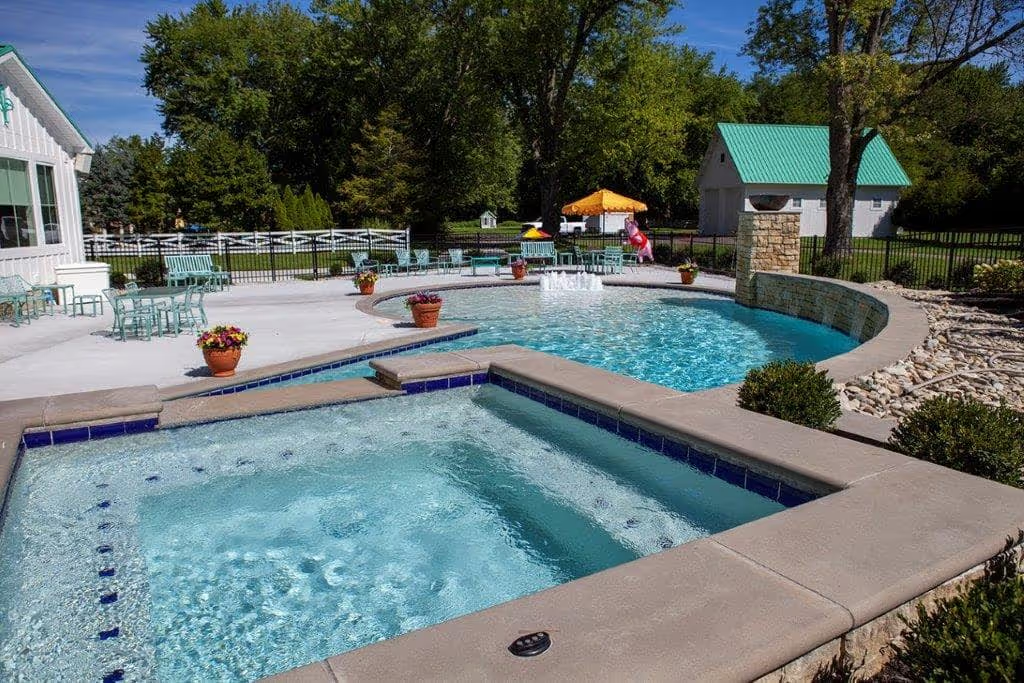- Stone Center
- Blog
Ultimate Guide to Natural Limestone Paving: Selection, Installation & Designs
23/7/2025
5/21/2025
Ultimate Guide to Natural Limestone Paving: Selection, Installation & Designs
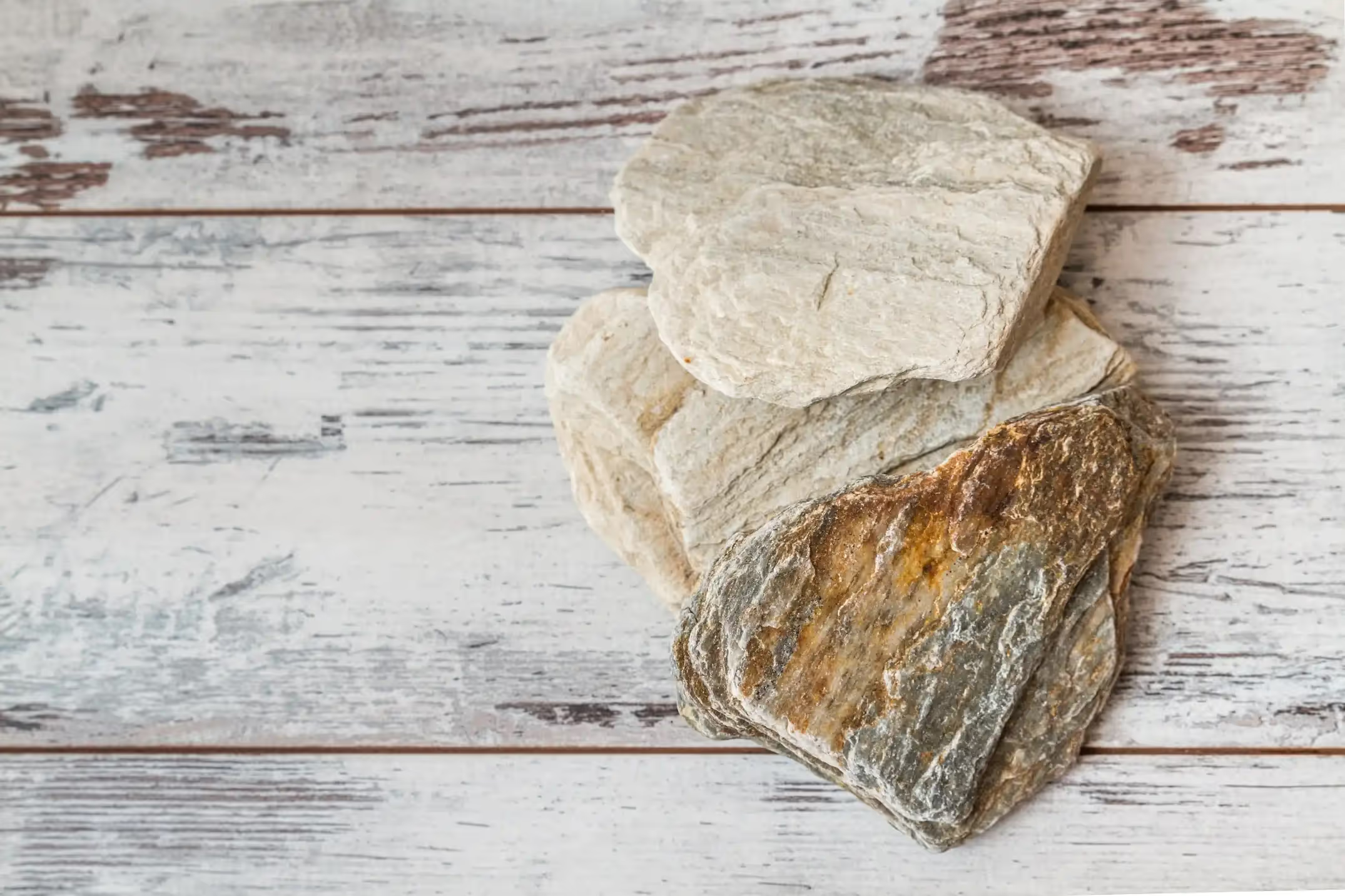
Looking to elevate your landscape with natural beauty and elegance? Limestone paving is a top choice for landscaping projects. Known for its durability and earthy charm, limestone comes in slabs that are perfect for patios, pathways, walls, and more. Available from your trusted landscaping stone supplier, limestone slabs come in warm, neutral hues like tan, cream, and gray that complement greenery and your overall aesthetic.
Whether you're refreshing a patio or designing an entirely new outdoor layout, this guide by our experts at Stone Center will walk you through everything you need to know about limestone slabs and pavers — from types and benefits to installation tips and real design inspiration. Let’s dive in and help you make an informed choice. Let's explore how limestone can help you pave the way to backyard bliss!
What Are Limestone Pavers?
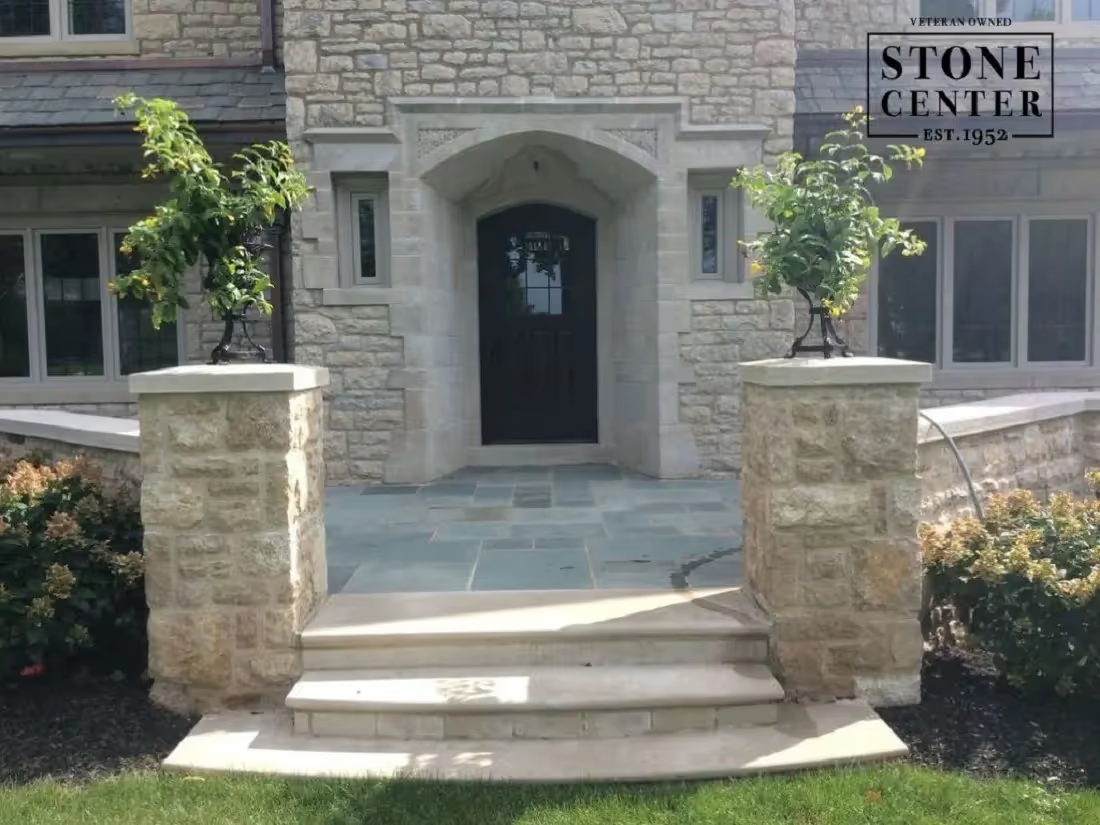
Limestone pavers are made from natural limestone, a sedimentary rock formed mainly of calcium carbonate. They come in many earth-tone colors and are durable, slip-resistant, and low maintenance. Unlike poured concrete, the natural variations and textures of limestone pavers create visual interest and offer timeless beauty, making these pavers a popular material for outdoor living spaces. Homeowners love using limestone pavers for driveways, patios, walkways, pool decks, and more, as it mimics the look of natural stone in a format that's easy to install and maintain.
What Are the Colors and Types of Limestone Paving?
When it comes to limestone paving, the options are incredibly diverse. We encourage you to explore the various types of limestone available. Each offers unique textures and colors to suit different aesthetic preferences. You can opt for the elegance of beige or cream-toned limestone, or the warmth of golden or honey-colored limestone. Some types of limestone may showcase natural veining or fossils, adding charm to your outdoor space. Limestone finishes range from smooth-honed surfaces perfect for modern designs to textured finishes that provide excellent slip resistance for pool decks and pathways.
Indiana limestone pavers, for example, represent one of the most popular and versatile options available today. Known for their consistent coloration and exceptional durability, these limestone products are timeless and elegant, complementing traditional and contemporary landscape designs.
Limestone Paving Pros and Cons
Limestone paving offers numerous benefits that make it a popular choice, but it also comes with certain considerations that might affect your decision. Let's explore each benefit and drawback in-depth below.
Benefits of Limestone Paving
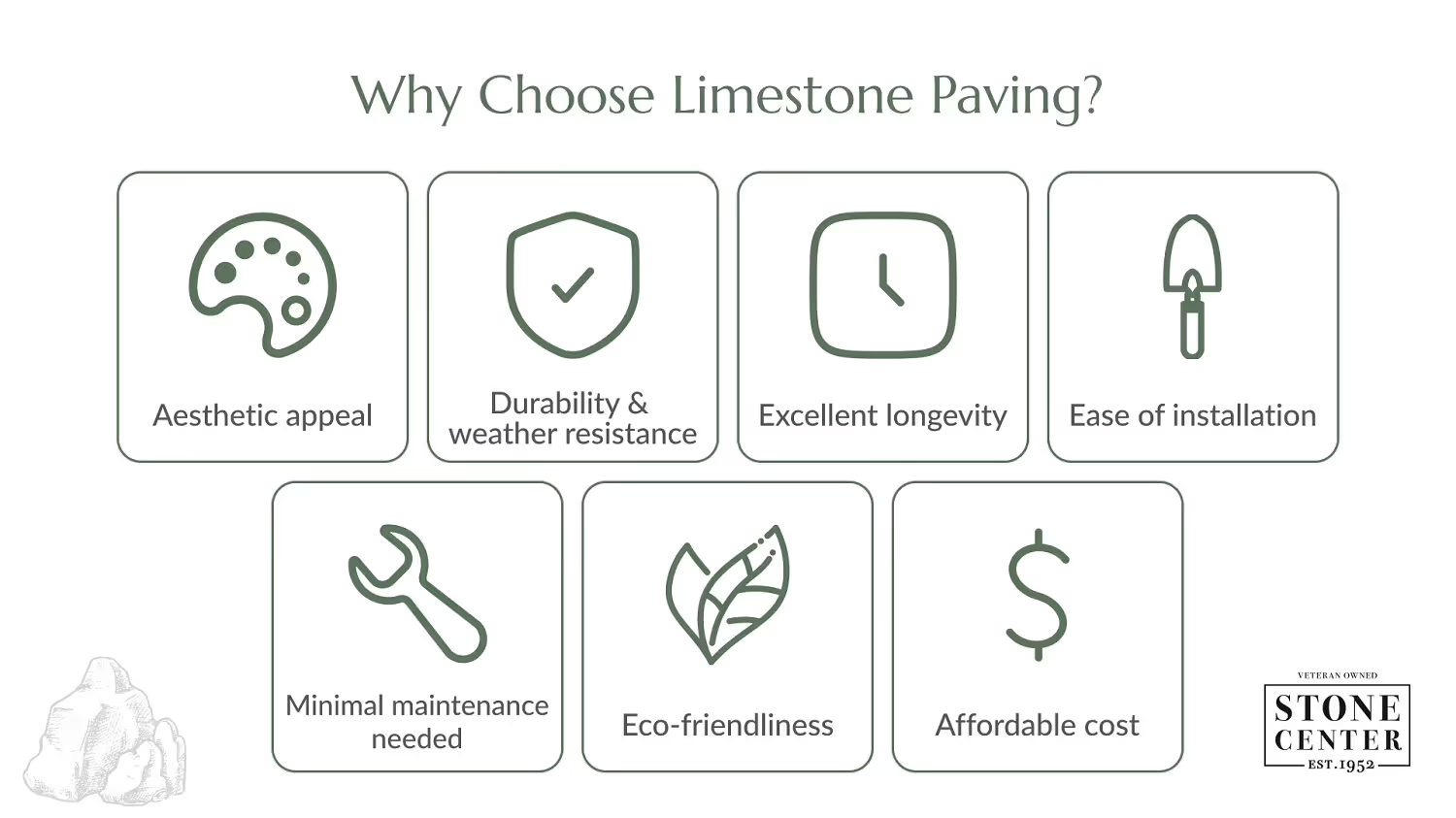
When many homeowners imagine paradise, limestone paving comes to mind. It offers a multitude of benefits, from its natural beauty and durability to its eco-friendliness and low maintenance requirements.
- Aesthetic appeal: Limestone paving brings natural beauty to any landscape. It has neutral tones and organic textures, meaning limestone can complement any space, including gardens, lawns, and other landscaping features.
- Durability and weather resistance: Limestone's naturally low porosity makes it highly resistant to water absorption and damage. The dense nature of natural limestone prevents excessive water infiltration, reducing the risk of erosion and maintaining stability. This characteristic also makes limestone highly durable and less prone to cracking or damage caused by freeze-thaw cycles.
- Excellent longevity: When properly installed and maintained, limestone paving can last 30 years or more. This remarkable lifespan makes it one of the most durable natural paving options available, outlasting many manufactured alternatives by decades.
- Ease of installation: Installing limestone pavers is an easy process perfect for DIYers. Limestone has a natural split surface finish, which means no cutting or polishing is required. Moreover, it can be installed on top of gravel or sand beds, and its lighter weight compared to other natural stones makes the installation process straightforward and fast.
- Minimal maintenance needed: Limestone paving requires little ongoing maintenance like occasional sweeping or hosing off. The non-porous surface of stone slabs or tiles resists staining and won't crack or peel like poured concrete. Limestone won't decompose like wood decking or require chemical treatments.
- Eco-friendliness: As a natural stone, limestone is a sustainable building material that doesn't require extensive energy or resources for production. Its long lifespan and durability also reduce the need for frequent replacements, minimizing waste and environmental impact.
- Affordable cost: Limestone pavers are competitively priced, typically ranging from $7-$15 per square foot without installation. That’s often more budget-friendly than granite or high-end sandstone paving options.
Drawbacks of Limestone Paving
While limestone offers numerous advantages, being aware of its limitations ensures you make an informed choice for your landscaping project.
- Requires sealing: Sealing is an added recurring maintenance requirement to protect limestone. It's not strictly necessary, but can help protect it from staining. As a bonus, proper sealing allows for easier cleaning.
- Sensitivity to acids: Limestone is sensitive to acids, including household cleaners, citrus juices, and certain foods. Contact with acidic substances can cause etching and damage to the surface of the pavers if not promptly cleaned.
- Not frost-proof: Freeze-thaw cycles can damage limestone that's not rated as frost-resistant.
- Can fade over time: Exposure to weather and sunlight can cause limestone pavers to gradually fade and lose their color.
- Susceptibility to scratches: Limestone is a softer stone compared to other materials like granite or concrete, so it's more prone to scratching. Heavy objects or sharp items may leave visible scratches on the surface.
- Color variations: Limestone pavers can have inconsistent coloring since they are natural stones.
How to Choose a Perfect Limestone Paver
To choose the ideal natural limestone for paving, make sure to factor in several considerations.
- Color and texture compatibility: Choose tones and surface patterns that match your home’s exterior and existing landscape design.
- Durability rating: Ensure the limestone’s strength can withstand your local climate and the intensity of daily use.
- Thickness requirements: Select thicker pavers for driveways and other vehicular areas; thinner ones suffice for garden paths and patios.
- Finish type: Decide between honed, bush-hammered, or natural finishes to achieve the right aesthetic and level of slip resistance.
- Porosity level: Lower porosity means less susceptibility to stains and discoloration.
Weighing all these factors will help you select the perfect natural limestone for your paving project.
Top 10 Paving Limestone Landscape Ideas
With many colors and options available, let your imagination run wild with luxe limestone pavers. Durable and elegant, they're ideal for creating stunning outdoor living spaces.
#gallery_start

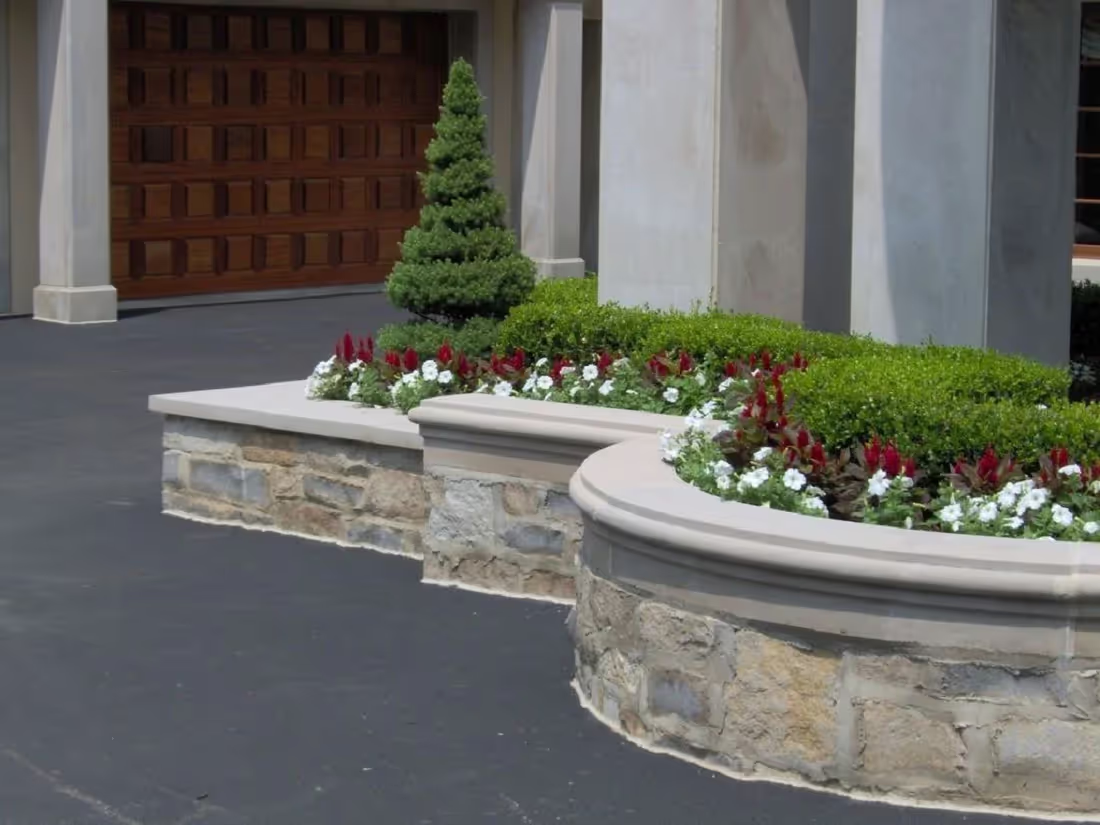

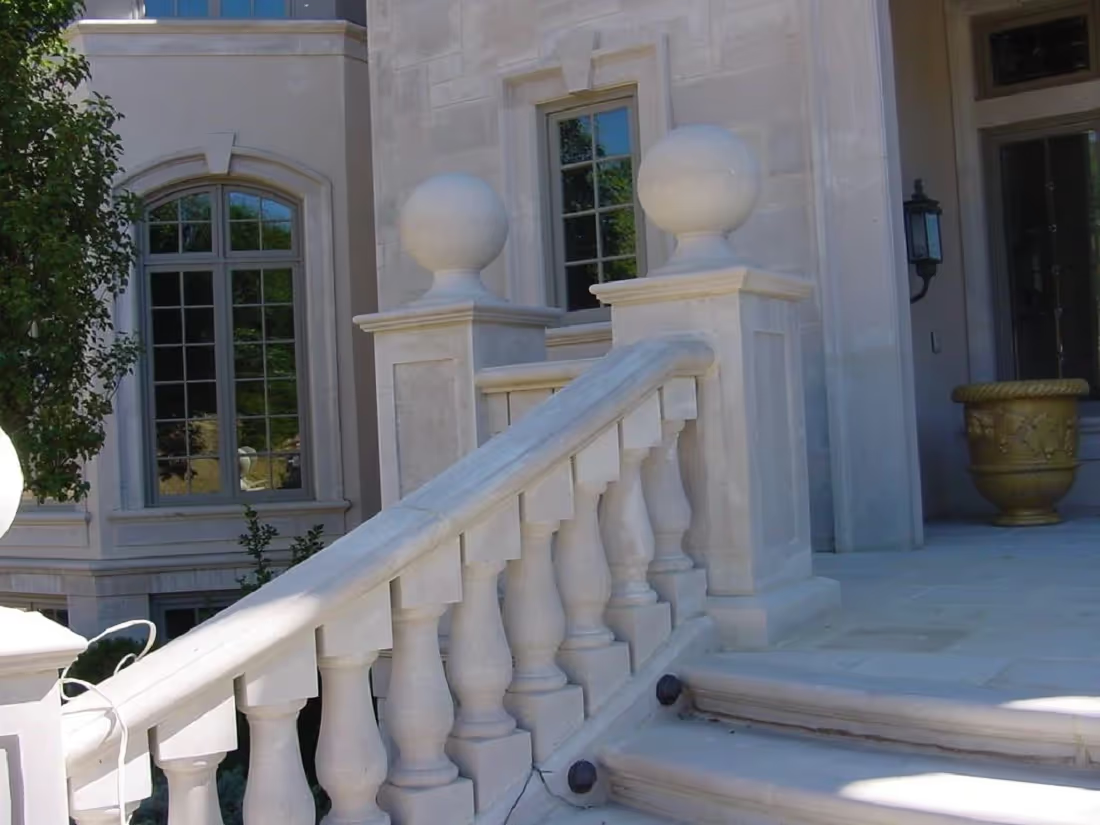

#gallery_end
1. Patio
Imagine paradise with a natural limestone patio design. Warm tan pavers laid in an organic pattern create a welcoming outdoor living space. The natural ridges and variations in the stone reflect the beauty of nature. Limestone's neutral tones allow for diverse decorating options.
Are you unsure of how many limestone patio pavers you'll need for your dream patio? Our patio paver calculator takes the guesswork out of your project by providing accurate estimates based on your dimensions.
2. Garden Borders
Another thing to consider is your garden borders. Define garden edges with natural limestone pavers. Use warm tan hues to complement foliage colors and opt for organic variations in the stone to reflect nature's beauty. As a bonus, durable limestone withstands the seasons. Lay pavers snugly for a clean border or space them apart for interest. Opt for limestone pavers to sit along the edge of garden beds to create a beautiful and durable landscape.
3. Walkways
Beyond patios, limestone pavers are ideal for creating walkways in dreamy garden landscapes. Meandering walkways bordered by limestone create a charming old-world feel. The natural tan hues complement colorful blooms in your garden. The variated texture enhances the organic feel while offering durability to withstand the elements.
4. Driveways
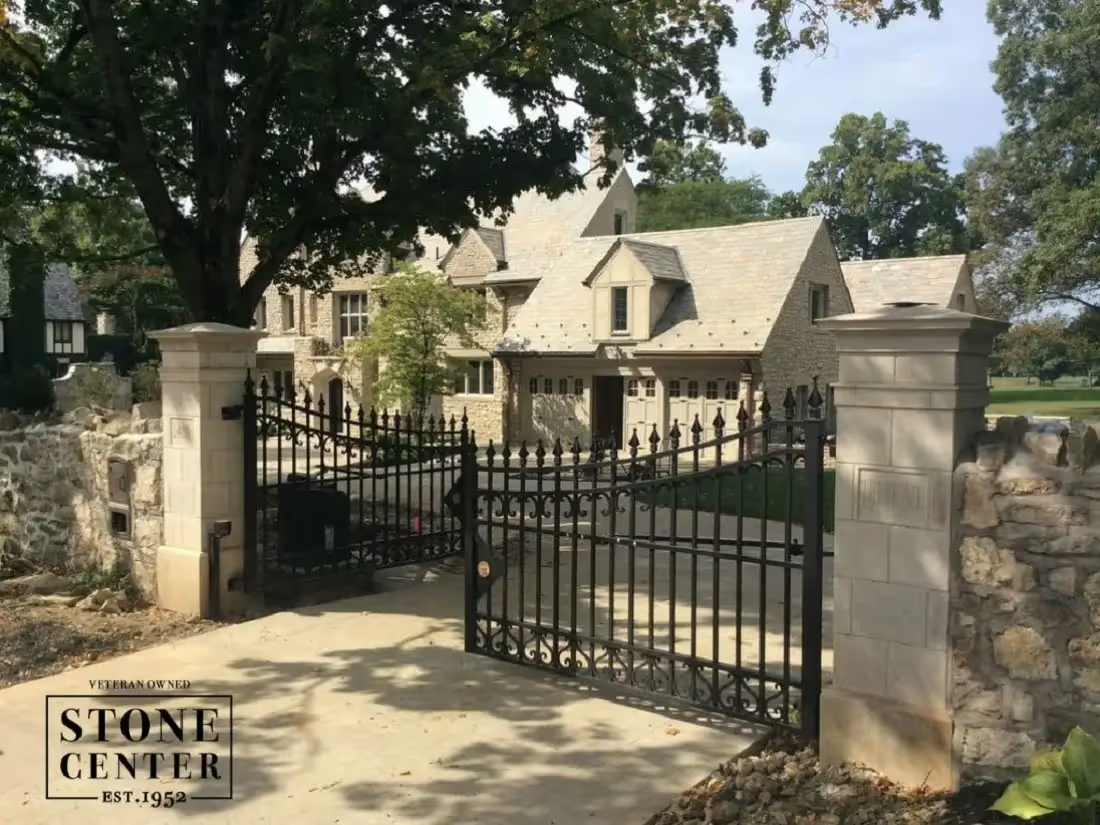
Don't overlook the beauty of your driveway. A simple way to enhance your curb appeal is by using limestone pavers for your driveway. Rich creamy tans, weathered grays, deep burgundies — limestone's natural palette provides options for any style. The stone's hardy composition stands up to vehicles while adding elegance to the entrance.
5. Courtyards
Transform your outdoor courtyard into a charming and intimate space with the warmth and natural beauty of limestone paving. They come in varied sizes and shapes to create organic patterns that invite exploration. Natural stones like limestone in your courtyard are a great way to add an elegant touch without breaking the bank.
6. Pool Decks
Using a limestone slab near your pool creates a luxe poolside retreat that resembles the look of marble. The cool, smooth stone underfoot surrounds the water while the varied natural tones complement poolscapes. Plus, limestone's durability means it can handle wet conditions with ease. Consider using limestone slabs to create an elegant foundation for poolside living.
7. Stepping Stones
Limestone paving can also be used as stepping stones to add an organic style to pathways. As they come in unique shapes and earthy hues, they look like stones uncovered from the garden floor. Limestone's durability withstands daily foot traffic. Get creative! You can space stepping stones apart for a whimsical feel or lay them snugly in a path.
8. Outdoor Kitchen

Tumbled limestone pavers create a covered outdoor kitchen floor with casual elegance. Varied shapes and soft edges lend an organic style. Neutral tan hues complement any design. Naturally slip-resistant, limestone stands up to spills and daily use. Let tumbled limestone pavers pave the way to effortless alfresco dining and entertaining.
9. Retaining Walls
Stacked limestone creates organic retaining walls that enhance landscapes and blend beautifully with plantings. Choose varied shapes and textures to add visual interest, and know that the inherent strength and durability of limestone will act in your favor. Using limestone for your retaining walls paves the way to defined garden beds or terraced yards.
10. Terrace or Balcony
Use limestone pavers for your terrace or balcony flooring, creating a serene and elegant space to enjoy outdoor views. Neutral tan hues complement potted greenery and flowers while varied shapes and organic textures reflect natural beauty. You'll have an inviting outdoor living space that's high above the ground.
How to Lay Limestone Pavers in 8 Steps
If you're considering laying limestone paving, follow these 8 simple steps for a successful and professional installation.
- Prepare the area: Start by clearing the area where you want to lay the limestone paving. Remove any existing vegetation, rocks, or debris. The ground should be level and compacted.
- Lay a foundation: Create a stable base by digging down a few inches and filling it with a layer of compacted clay. This provides a solid foundation for your pavers.
- Add a layer of sand: Spread a layer of sharp sand over the compacted clay. If needed, use a rake or screeding board to even out the sand and create a smooth, level surface.
- Start laying the pavers: Begin laying the limestone pavers from one corner of the area. Place each paver gently on the sand, leaving a small gap (about 3-5mm) between them for jointing.
- Check for levelness: Use a spirit level to ensure the pavers are level. Adjust the height of each paver by adding or removing sand as necessary.
- Fill gaps with mortar or rock dust: Once all the pavers are laid, fill the gaps between them with either mortar or rock dust. Mortar is more durable but may require more effort, while rock dust provides a more natural look.
- Compact and finish: Rent a compactor or tamper to gently compact the pavers into the sand bed. This will ensure they are well-settled and stable. Brush off any excess sand or dust from the surface of the pavers.
- Allow for curing: Give the mortar or rock dust time to cure as per the manufacturer's instructions before walking or placing any significant weight on the newly laid limestone paving.
These steps will help you successfully lay your limestone pavers and create a beautiful and durable outdoor space.
Safety tip: Always remember to wear protective gloves and goggles when working with materials like mortar or rock dust.
Are There Alternatives to Limestone Pavers?
The world of paving limestones offers a variety of options to suit different preferences and project requirements. We've outlined some alternatives for you to consider.
Flagstone
Flagstone is one of the most popular natural stones for paving. It comes in a variety of earthy tones as well as in flat, irregular pieces of varying sizes. The natural split finish of flagstone creates rustic, organic patterns when installed. The material is durable and low maintenance, and flagstone brings antique old-world charm to pathways, patios, and courtyards. There are many types of flagstones to choose from for your projects.
Bluestone
Native to the northeastern U.S., bluestone gets its distinctive hue from traces of feldspar minerals. It comes in a natural cleft finish, and the smooth, fine-grained surface of bluestone stands up well to weathering. Bluestone can provide an elegant paved patio, walkway, or pool surround with its range of blue, grey, and buff limestone colors.
Travertine
With its distinct pitted surface and earthy tones, travertine is a unique paving material known for its ornamental qualities. It's formed by mineral deposits from hot springs and it exhibits cavities that create an uneven, porous texture. When used for patios, walkways, and pool decks, the rustic layered look of travertine's natural texture provides Old World charm and elegance to outdoor living spaces. When comparing travertine vs. limestone, travertine has more surface pitting and a more antique appearance, while limestone offers smoother surfaces and softer tones.
Slate
Slate is a popular choice for natural stone paving due to its durability and range of gray tones. It's formed from compressed mud and ash over millions of years, so slate has a dense structure that stands up well to heavy foot traffic. The natural cleft finish of slate showcases fine layers and veining in hues of charcoal, blue-gray, purple, and green. Slate's hardness and water resistance make it ideal for walkways, patios, pool surrounds, and driveways.
Create Naturally Beautiful Outdoor Spaces with Limestone Pavers
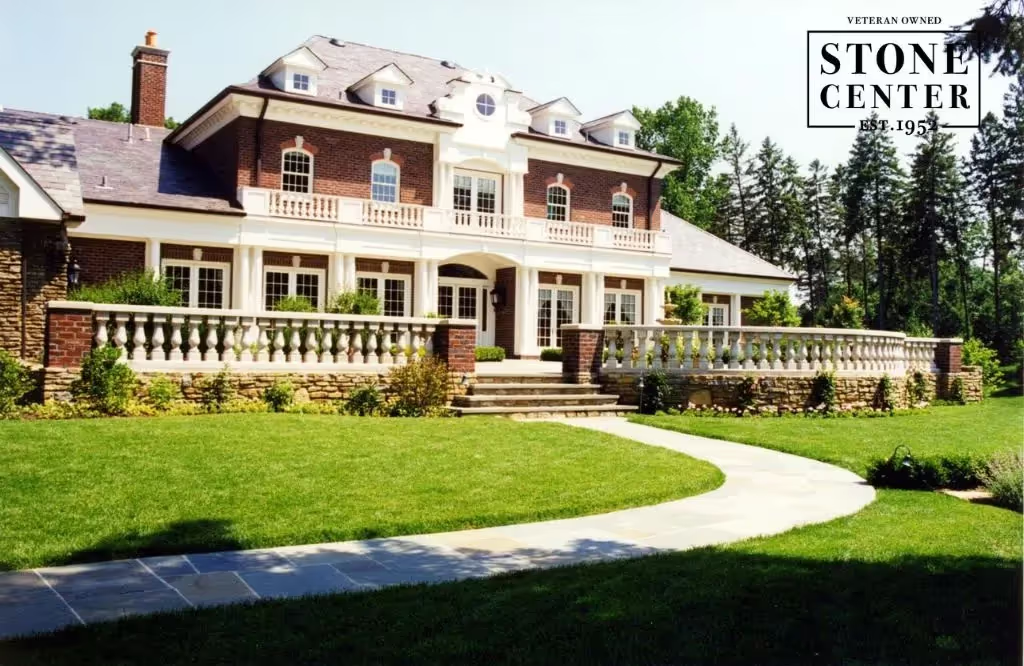
Even though there are alternatives, there's a reason why limestone is so popular. It's an easy way to bring elegance and charm to your outdoor living areas at an affordable price. It offers durability and timeless beauty to create landscapes that last.
Visit Stone Center in Columbus or Cincinnati to explore our selection of quality limestone paving options and slabs for your next landscaping project. Our friendly and knowledgeable staff can help you choose the perfect limestone materials to suit your vision and needs. Contact us today to make your property picture-perfect with natural limestone pavers and slabs!
FAQ
FAQ
Is limestone a good paver?
Yes, limestone is an excellent choice for pavers. It has a beautiful natural aesthetic, stands up well to weather and wear, and comes in a range of earthy colors that complement landscaping. Limestone adds charm and value to pathways, patios, and more.
How do you clean and maintain limestone?
For routine limestone cleaning, sweep away debris and use a pH-neutral soap and water. For stains, use a poultice or cleaner made of natural stone. Reseal limestone every 1-3 years as needed. Take care not to use acidic cleaners which can damage the limestone.
How much does a limestone patio cost?
For 2025, a limestone patio typically costs $15-$30 per square foot installed. Factors like stone type, pattern complexity, accessibility, base preparation, and labor will impact cost. Expect a basic 400-square-foot limestone patio to cost around $6,000-$12,000 on average.
.avif)
Jon, the owner of Stone Center, is a knowledgeable expert in natural stone products, specializing in various types of stone for landscaping and architectural projects. Passionate about promoting the beauty and versatility of natural stone, Jon aims to use these blogs to inspire readers with creative ideas to upgrade their homes.
How much does it cost to get a stone restored?
How much you end up spending to restore stone varies on the type of stone, the technique, and the stone’s current condition. Stone in good condition will cost less to restore, whereas stone that has a lot of wear and tear may require a longer restoration.






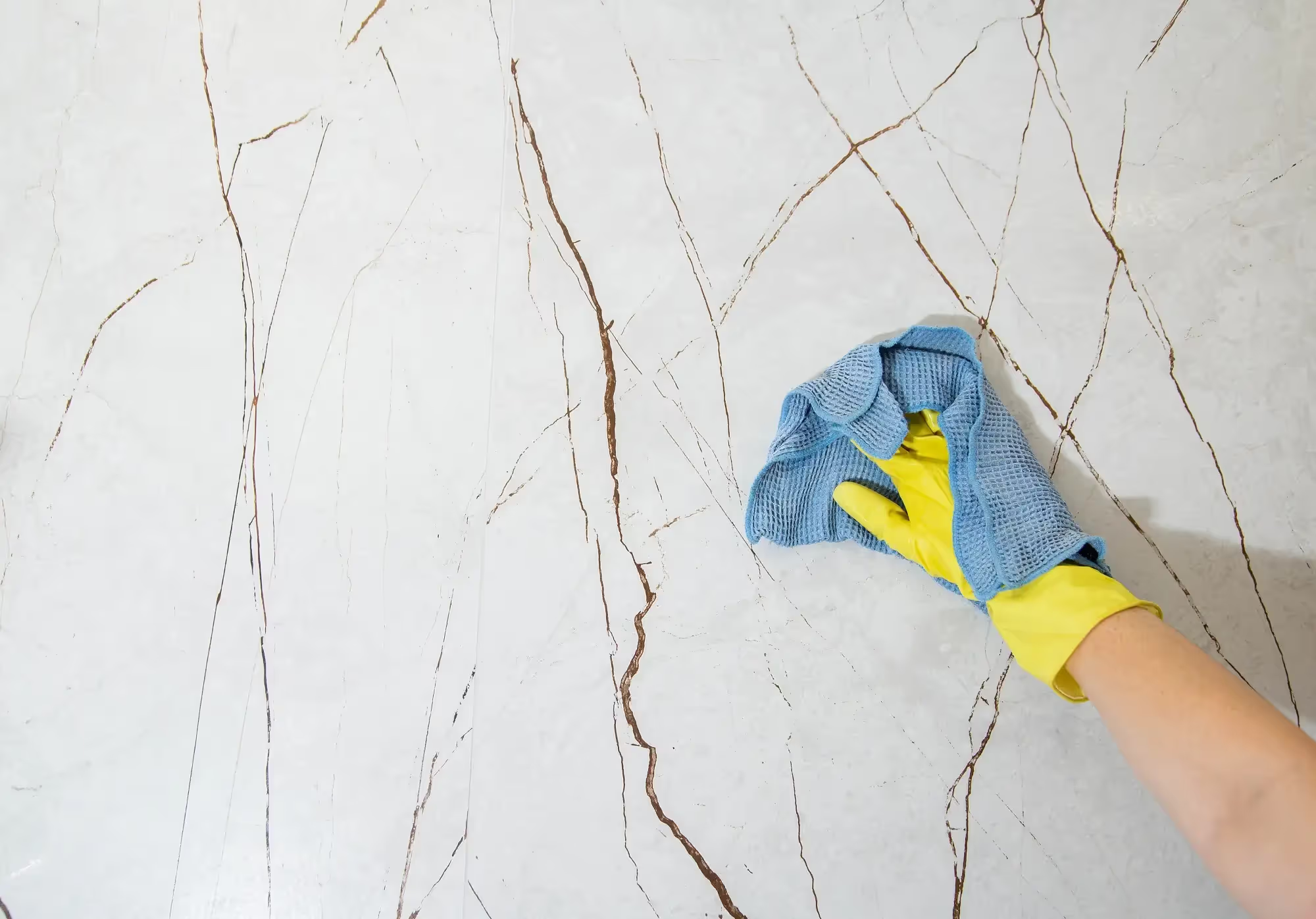
%20(1).avif)
.avif)
%20(1).avif)
%20(1).avif)
